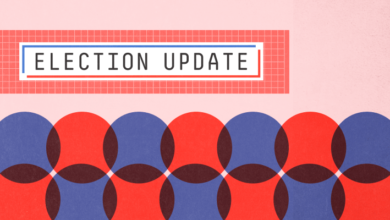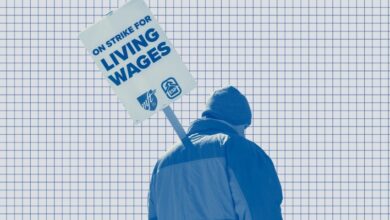
[ad_1]

Michael M. Santiago / Getty Images
Inflation isn’t under control, and we’re heading for a recession. Except, wait: The latest jobs report indicates that the labor market is healthier than it’s been in years. So maybe we’re heading for the fabled “soft landing” as the Federal Reserve tries to curb inflation. Except, wait: That jobs report was too good, which means that the Fed will hike rates even higher — and economic pain is coming.
You’re confused. We’re confused. Who isn’t confused? Economic signals are pointing in different directions, and with every new data release comes a new batch of headlines declaring that our odds of heading into a recession are higher or lower than they were before.
The reality is that everyone is guessing. Let’s not forget that economists are bad at predicting recessions, and the economy is particularly weird right now. Inflation, for example, hadn’t been a serious issue for nearly four decades — but now it’s framing the way everyone is thinking and talking about the economy. Even though it probably won’t make anyone more certain about what happens next, it’s worth trying to understand what the indicators are saying when they’re taken together.
It’s not a clear story, and there are very different ways to present the data. Here are two possibilities for the next few months, and the evidence that does — or doesn’t — support each scenario.
A strong labor market — and slowing inflation — means we’re heading for a soft landing
This is the most optimistic outlook for the economy in the near term, as it suggests that the Fed will continue to bring down inflation without having to accelerate rate increases and cause too much harm to the economy — particularly as it relates to the labor market — perhaps even avoiding a recession altogether. Put differently, this scenario suggests that we can have our cake and eat it, too, as far as it comes to achieving both price stability and maximum employment.
And it’s not the view of just the sunshine-pumpers to suggest that we’re heading for a soft landing, nor is that outlook, as former Treasury Secretary Larry Summers put it, “at odds with both economic theory and evidence.” The latest data released, for January 2023, shows that inflation has cooled to a year-over-year rate of 6.3 percent since its July 2022 peak of 8.9 percent, and yet the unemployment rate has stayed stubbornly low at 3.4 percent, the lowest figure in more than a half-century.
Typically, when the Fed raises interest rates to counteract inflation (or fears of it), it comes with a tradeoff: a pretty crappy economy. In the 1980s, the central bank took a markedly aggressive approach to combating inflation, raising rates to a sky-high 19 percent to bring inflation down from a mark of nearly 15 percent. This move caused a deep — but arguably necessary — recession, and it’s an episode that has informed the thinking of not just economists and Fed officials in the decades since, but ordinary Americans as well.
But one reason history might not repeat itself is a fundamental difference in the current labor market. You may recall that, prior to the pandemic, the U.S. economy was flourishing. A lot of that had to do with the relative strength of the labor market, as broad-based growth in sectors ranging from health care to construction led to a historically low unemployment rate and improving labor-force participation rate, signaling a boom. And now, it appears that we have recaptured that economy in many ways — replete with a very low unemployment rate and many, many job openings. That’s unlike when the Fed started its ultra-aggressive approach in the late 1970s, when inflation and unemployment were significantly higher, and when the economy had been struggling through a crisis of “stagflation.”
“The labor market is so tight that it’s hard to see how we can experience something like back in the ’80s,” said Fernando Martin, assistant vice president in the research division at the Federal Reserve Bank of St. Louis. “You’re not going to see big increases in GDP growth or anything like that. But unless we start seeing indicators that the labor market starts deteriorating, it’s hard to start predicting a recession in the traditional sense.”
Finally, if you hold that the recent inflation we saw was largely the byproduct of gummed-up supply chains, then there’s even further reason for optimism. Signs point to supply chains having improved since the height of the pandemic, which has potentially contributed to easing inflation and suggests that the Fed can continue bringing prices down without resorting to 1980s-style monetary engineering.
“The Fed is trying to reduce aggregate demand, but with supply chains repairing at the same time, they don’t need to reduce aggregate demand so sharply that we actually get rising unemployment,” said Carola Binder, a professor of economics at Haverford College. “So I think it does seem possible to have a soft landing — and seems fairly likely, even.”
Inflation isn’t under control, and the labor market is too tight — so we’re probably heading for a hard landing
Let’s not get too happy yet, though. Several economists we spoke with cautioned that not all of the indicators are as good as they look at first glance, and a recession could still be coming.
The logic behind this is fairly simple: Although inflation seems to be ebbing, it’s not slowing as quickly as the Fed wants. And that really strong labor market could be too strong for the Fed’s liking, since if workers — not jobs — are in demand, employers will be under pressure to raise wages. This could then lead to higher costs for consumers as companies try to compensate, while people also have more money to spend. To make sure that doesn’t happen, the Fed seems almost certain to continue on its rate-hiking journey, which could end up slowing down the economy too much.
“Inflation has a long way to go by any measure, and I don’t see how you can get inflation down with wage growth the way it is,” said Jonathan Wright, an economics professor at Johns Hopkins University. “And given a fairly tight time horizon, I think the Fed will err on the side of doing too much.”
The argument that economists like Wright are making is that yes, it’s possible for a soft landing to happen — but conditions have to stay pretty much ideal for that to become reality. And Wright said that there’s a lot of room for things to go sideways. There might not be a lot of competition for jobs, for one thing, but the share of people either working or actively looking for a job (62.4 percent in January 2023) is still lower than it was before the pandemic (63.3 percent in February 2020). “What you’d like to see is everyone back in the labor force, but for older workers, it looks like labor-force participation may be permanently lower,” he said. To him, this means that the current trajectory of the labor market is unsustainable — and preventing high wage growth (which could drive inflation higher) will require stronger intervention from the Fed than we’ve already seen.
Another sign that the Fed may soon come in harder, Wright said, is that financial markets aren’t behaving as if the Fed has been consistently hiking rates for almost a year. For example, mortgage rates fell for several weeks in January after rising for most of 2022. They’ve spiked again in the past couple of weeks, but it was a troubling signal for Wright, who said that generally speaking, financial conditions have been “much easier” than they should be given the Fed’s actions — and that could undercut the Fed’s work, prompting them to push for even more aggressive rate hikes in the future.
Recessions can also be hard to see while they’re happening — there’s a reason why the official determination of recessions, made by the National Bureau of Economic Research, is backward-looking. And there are a few clues that the economy could already be weakening. For instance, the industrial production index declined in both November and December and was flat in January, sparking speculation that we’re already in a “manufacturing recession.” Business sales also somewhat faltered in the fall, which could be another reason for pessimism.
Ryan Sweet, chief U.S. economist at Oxford Economics, said that he thinks a soft landing is possible — it just isn’t likely, given how many things have to go right to keep the economy on track. “We could skirt [a recession], but it will take luck,” he said. That doesn’t mean, though, that we’re heading for a deep or prolonged economic decline, like the Great Recession. If a recession does happen, Sweet thinks it would be because the Fed made a “policy error” in hiking rates too aggressively. “Historically, those are mild recessions,” Sweet said. “If the unemployment rate goes up by a percentage point, that means the economy is softening and it will be uncomfortable. But the NBER might not even date it as a recession.”
Of course, if the COVID-19 economy has taught us anything, it’s that we shouldn’t be completely comfortable about using these indicators to make predictions. It isn’t just a feature of the pandemic, either, as economists are notorious for incorrectly predicting when the next recession will come about. That uncertainty has washed over onto our understanding of the economy during the pandemic, as we’ve transitioned from boom, to bust, to potentially too much boom over the past 36 months.
Another potential danger lies in assuming that all recessions look the same and that our not-so-trusty indicators can tell the full story, even when it appears they’ve accurately predicted our fate. Martin referred to how one key indicator of recessions that experts look to, an inverted yield curve, “predicted” the COVID-19 recession — but months before anyone knew of the virus’s devastating capacity.
“If you look at the data, well, a recession happened,” Martin said. “But you know, [the inverted yield curve] had nothing to do with anything. That was a completely unexpected shock and a cautionary tale of indicators and predictive power.”
Maybe the lesson is that we’re flying blind, or that our navigation of the economy can only be so precise. No matter the outcome, though, we’ll know in the coming months and years whether our economic engines have made a hard — or soft — landing on the proverbial tarmac.
Source link



